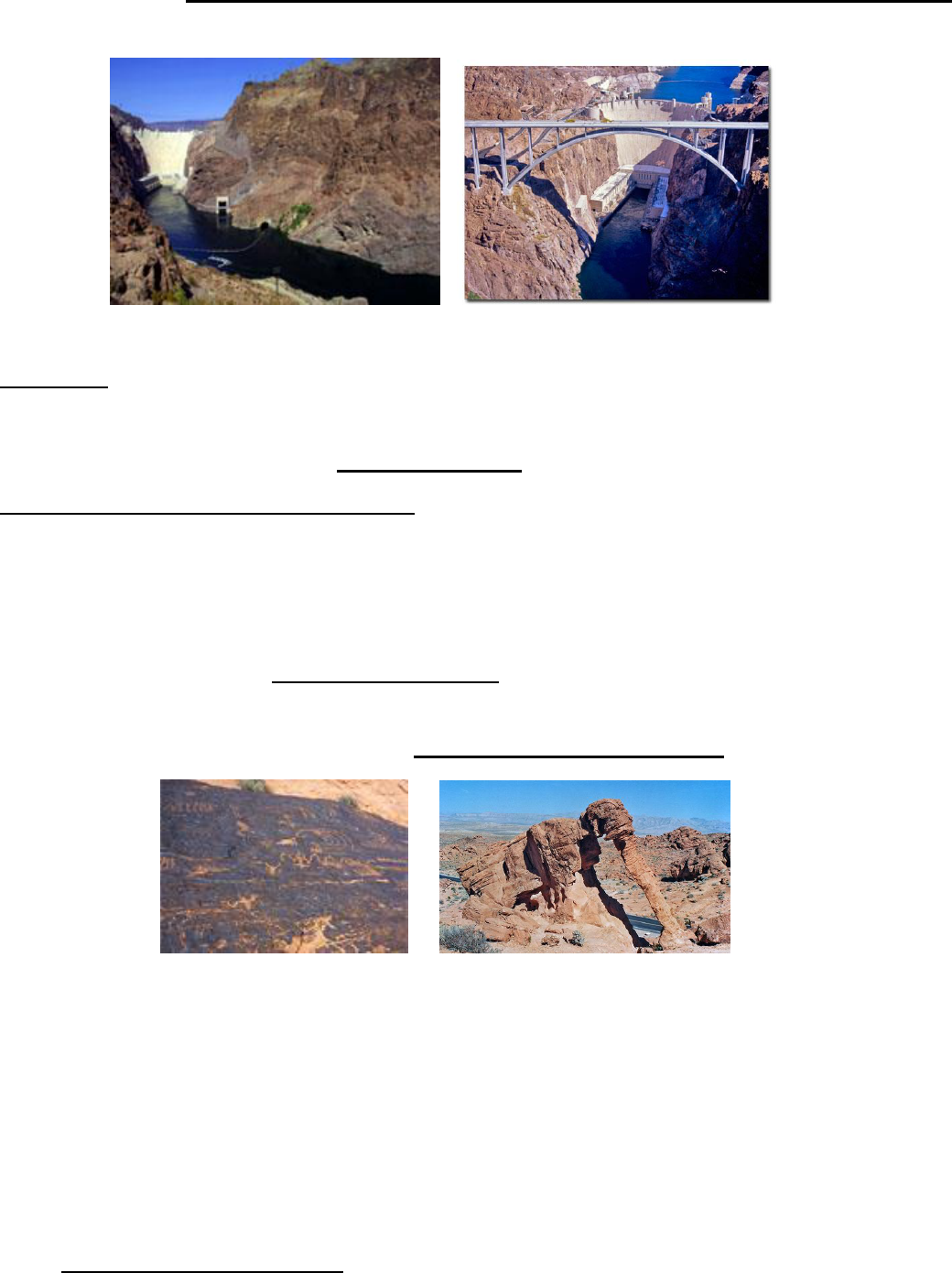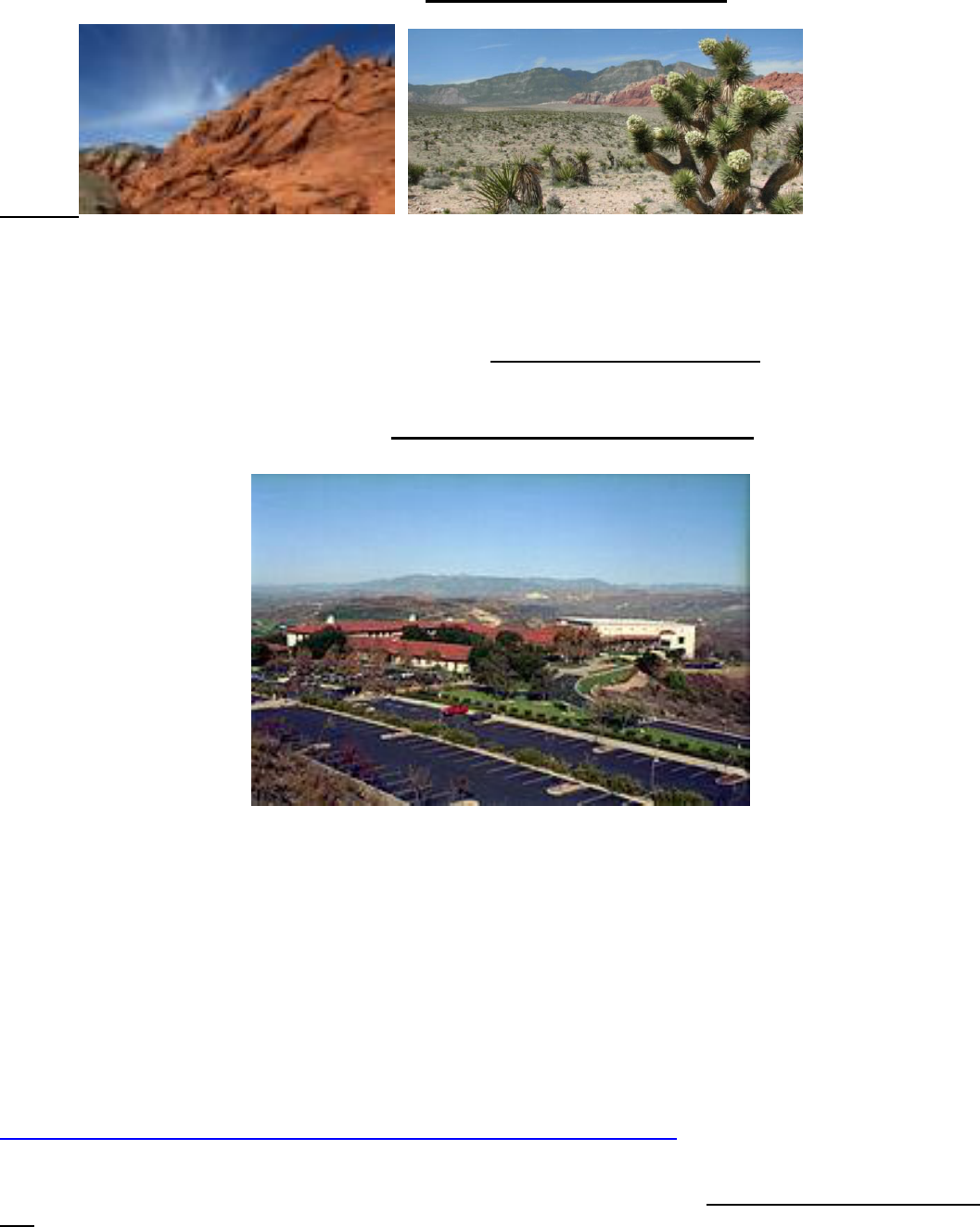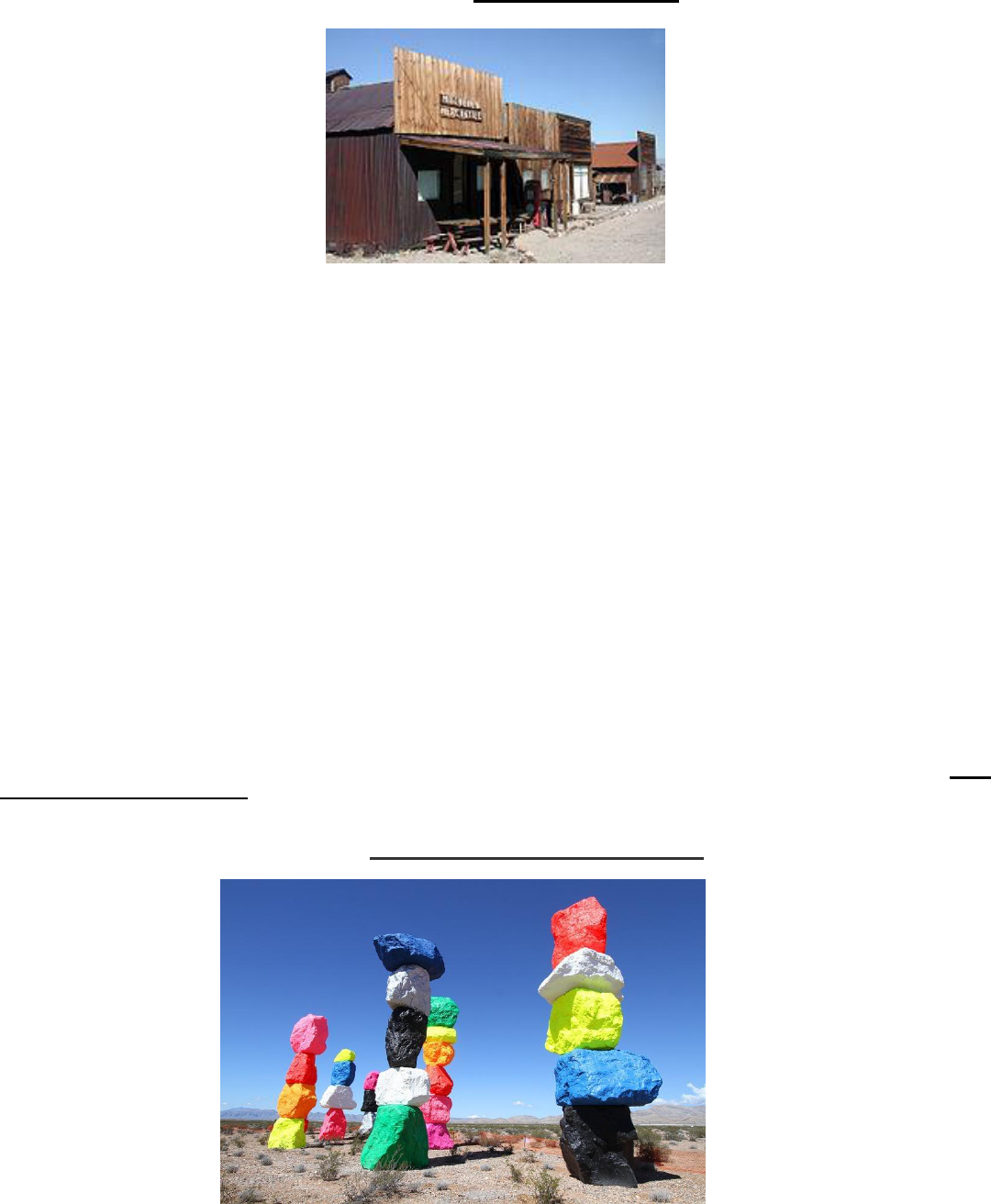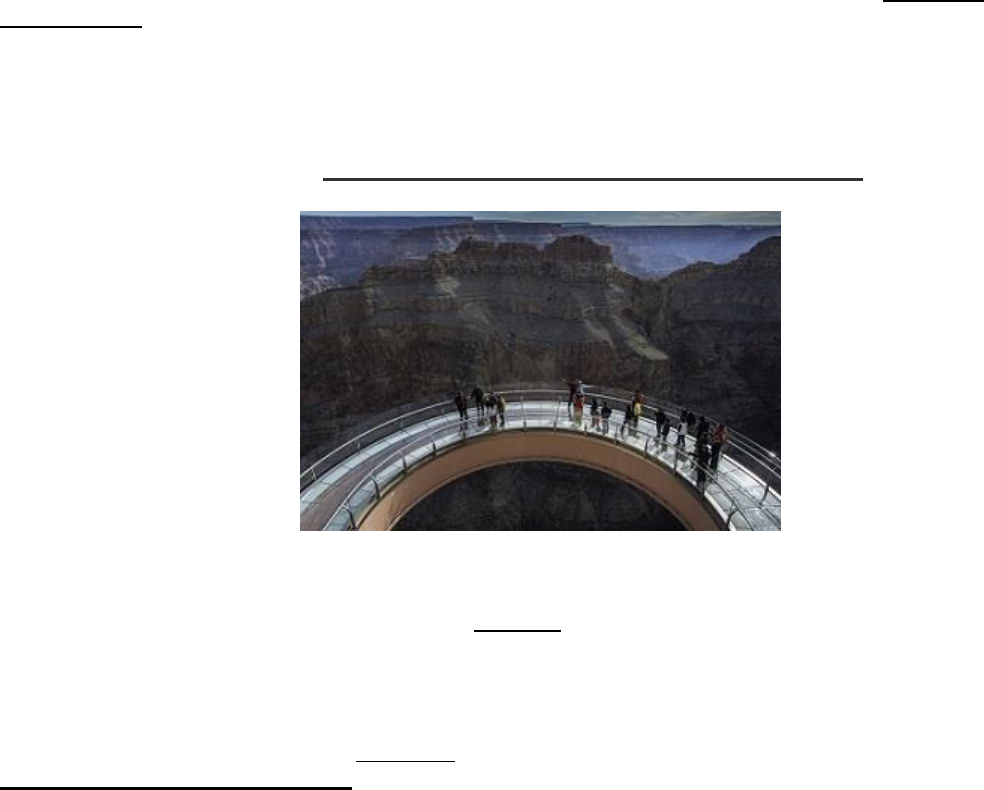
Interesting Things to Do in the Southern Nevada Area
Option #1: Death Valley National Park
Distance from Las Vegas: Approx 120 miles west... 2 hr drive
A unique and memorable experience. Hottest, Driest, Lowest...
In this below-sea-level basin, steady drought and record summer heat make Death Valley a land of extremes. Yet,
each extreme has a striking contrast. Towering peaks are frosted with winter snow. Rare rainstorms bring vast
fields of wildflowers. Lush oases harbor tiny fish and refuge for wildlife and humans. Despite its morbid name, a
great diversity of life survives in Death Valley.
Things to consider:
A full day trip with an early morning departure due to distance and temp (6:00 am recommended with a stop
for breakfast). Return in late afternoon/early evening (5:00 to 6:30pm)
Temperature will likely be in the 115+ range.
Much of Death Valley would be seen from the comfort of an air-conditioned auto.
Bring a camera, sun screen, a hat... lots of water will be provided.
Option #2: Mt. Charleston and the Spring Mountains
Distance from Las Vegas: 38 miles West (to the Mountain lodge).... 1 hr drive
Mount Charleston is a year-round getaway for Las Vegas' residents and visitors, with a number of hiking trails
and a modest ski area. The mountain, which is snow-capped more than half the year, can be seen from parts of
the Las Vegas Strip when looking toward the west. Mount Charleston has nearly 200 camp sites and over 150
picnic areas, some of which are RV accessible. The eponymous village of Mount Charleston lies at its base to the
east. The area includes two major canyons (Lee and Kyle) interconnected by a year round hard surface scenic
road providing spectacular views of near by military and former atomic test ranges. Tour time estimate with
travel and lunch: 5-6 hrs

Option #3: Hoover Dam and the Mike O'Callaghan - Pat Tillman Bridge
Distance from Las Vegas: 35 miles Southeast.... 1 hr drive
Hoover Dam: Constructed in the 1930s by 21,000 men who used supplies from every state, Hoover Dam is 726
feet tall and 660 feet thick at the bottom to hold back the water pressure of 45,000 pounds per square foot.
There’s enough concrete in Hoover Dam (4.5 million cubic yards) to build a four-foot wide sidewalk around the
Earth at the Equator. Every second during peak electricity periods, enough water runs through the generators to
fill 15 average-sized swimming pools. Tour time est: 2.5 hrs
Mike O'Callaghan - Pat Tillman Memorial Bridge: The bridge consists of four lanes and alleviates a number of
problems associated with the old U.S. 93 that passed over the Hoover Dam itself. The narrow, winding two-lane
road could no longer handle the 14,000 cars that passed over the dam daily causing congestion. The design of
the road was dangerous with two hairpin turns, blind curves and pedestrian traffic. There were also vehicle
restrictions on the Hoover Dam and loaded trucks and buses with luggage couldn't pass over it. Since 9/11
trucks and other unauthorized vehicles had to go through Laughlin, NV to cross over the Colorado River. The
total project cost was $240 million. It was funded by the federal government ($100 million); by Arizona and
Nevada, who each spent $20 million; and the balance will be paid for by bonds. The project was expedited after
the tragic 9/11 terrorist attack. Tour time est: 45 minutes.
Option #4: Valley of Fire State Park
Petroglyphs Amazing and Colorful Rock Formations
Distance from Las Vegas: 43 miles Northeast... 45 minute drive
Much of the park is seen from close proximity to the car. Vast areas of Red rock are exposed at scattered
locations all over the desert adjoining the west side of Lake Mead. The state park boundaries enclose the most
interesting formations, found along 10 miles of the highway and extending over 30 miles to the north, over a
large area of mostly trackless land almost as far as Glendale, at exit 90 of the interstate. The exposed rock
responsible for the dramatic colors and formations is Aztec sandstone, formed by petrifaction of ancient sand
dunes during the Jurassic era (ca. 160 million years ago). The park has a new visitor center near the west
entrance. There are various viewpoints and named features along the main road (NV 169), including several short
foot paths, and arguably even better scenery along the 6 mile scenic drive (White Domes Road) which forks
northwards by the visitor center; along here are found more viewpoints and the most popular trails, plus rocks in
a range of other colors besides red. A "must see" trek is to 'Mouse's Tank'... a scenic walk thru a petroglyph filled
wash. Tour and travel time est: 5.5 hrs.

Option #5: Red Rock Canyon Park
Distance from Las Vegas: 20 miles West... 40 minute drive
Red Rock Canyon features a one-way 13-mile scenic drive, a Visitor Center offering information and
interpretation about recreation opportunities, hiking and trails, wildlife, vegetation, geology, cultural resources
and much more. The facility also offers a book and gift store. A popular area for rock climbing (requires a permit).
A few off road walking trails exist throughout the park. Tour and travel time est: 3 hrs.
Option #6: Raegan Presidential Library
Distance from Las Vegas: 308 miles West... 4;30 hr. drive.
The Ronald Reagan Presidential Library and Center for Public Affairs is the presidential library and final resting
place of Ronald Wilson Reagan, the 40th President of the United States (1981–1989), and his wife Nancy Reagan.
Designed by Hugh Stubbins and Associates, the library is located in Simi Valley, California, about 40 miles
(64 km) northwest of Downtown Los Angeles and 15 miles (24 km) west of Chatsworth. The Reagan Library is the
largest of the 13 federally operated presidential libraries. The street address, 40 Presidential Drive, is numbered
in honor of Reagan's place as the 40th President. The museum features continually changing temporary exhibits
and a permanent exhibit covering President Reagan's life. This exhibit begins during Reagan's childhood in
Dixon, Illinois, and follows his life through his film career and military service, marriage to Nancy Davis Reagan,
and political career. The "Citizen Governor" gallery shows footage of Reagan's 1964 "A Time for Choosing"
speech and contains displays on his eight years as governor. The gallery includes a 1965 Ford Mustang used by
Reagan during his first gubernatorial campaign, as well as the desk he used as governor.
https://en.wikipedia.org/wiki/Ronald_Reagan_Presidential_Library - cite_note-13 His 1980 and 1984 presidential
campaigns are also highlighted, as well as his inauguration suit and a table from the White House Situation
Room is on display. News footage of the 1981 assassination attempt on his life is shown, and information about
the proposed Strategic Defense Initiative (SDI, dubbed "Star Wars") is included. Tour and travel time est: 13- 14
hrs.

Option #7: Goldfield, NV
Distance from Las Vegas: 188 miles West... 2 hr 50 min minute drive.
Goldfield was a boomtown in the first decade of the 20th century due to the discovery of gold — between 1903
and 1940, Goldfield's mines produced more than $86 million. Much of the town was destroyed by a fire in 1923,
although several buildings survived and remain today, notably the Goldfield Hotel, the Consolidated Mines
Building (the communications center of the town until 1963), and the schoolhouse. Gold exploration continues in
and around the town today. Tour and travel time est: 9-10 hrs.
Option #8: Rhyolite, NV
Distance from Las Vegas: 131 miles... 2 hr drive.
Rhyolite is a ghost town in Nye County, in the U.S. state of Nevada. It is in the Bullfrog Hills, about 120 miles
(190 km) northwest of Las Vegas, near the eastern edge of Death Valley. The town began in early 1905 as one of
several mining camps that sprang up after a prospecting discovery in the surrounding hills. During an ensuing
gold rush, thousands of gold-seekers, developers, miners and service providers flocked to the Bullfrog Mining
District. Many settled in Rhyolite, which lay in a sheltered desert basin near the region's biggest producer, the
Montgomery Shoshone Mine. Industrialist Charles M. Schwab bought the Montgomery Shoshone Mine in 1906
and invested heavily in infrastructure, including piped water, electric lines and railroad transportation, that
served the town as well as the mine. By 1907, Rhyolite had electric lights, water mains, telephones, newspapers,
a hospital, a school, an opera house, and a stock exchange. Published estimates of the town's peak population
vary widely, but scholarly sources generally place it in a range between 3,500 and 5,000 in 1907–08. Rhyolite
declined almost as rapidly as it rose. After the richest ore was exhausted, production fell. The 1906 San
Francisco earthquake and the financial panic of 1907 made it more difficult to raise development capital. In 1908,
investors in the Montgomery Shoshone Mine, concerned that it was overvalued, ordered an independent study.
When the study's findings proved unfavorable, the company's stock value crashed, further restricting funding.
By the end of 1910, the mine was operating at a loss, and it closed in 1911. By this time, many out-of-work miners
had moved elsewhere, and Rhyolite's population dropped well below 1,000. By 1920, it was close to zero. Tour
and travel time est: 7- 8 hrs.

Option #9: Gold Point, NV
Distance from Las Vegas: 130 miles... 2 hr drive.
The area that would become Gold Point was first settled by ranchers and a few miners during the 1880s. The
small camp of Lime Point was formed a few hundred yards West of the present town, at an outcropping of
limestone. When new discoveries of gold and silver established the major mining towns of Tonopah and
Goldfield, Nevada in the early 1900s, a flood of prospectors returned to Lime Point. In 1902 silver was discovered
in the area, and the old camp was revived and renamed Hornsilver (an informal name for the silver mineral
chlorargyrite). Scarcity of water in the area required that the ore be shipped to nearby Lida for milling. The
nearest major supply town was about 250 miles north at Unionville, a mining town northeast of present-day
Lovelock. The miners did not find silver in abundance, the costs of shipping the ore to Lida became too high,
and, within a year, the settlement was abandoned. In 1905, the Great Western Mine Company began operations
about a half mile southeast of Hornsilver and discovered a rich silver vein which brought a stampede of miners
back to the camp. In addition to the rich silver ore, gold was also mined in small quantities. By 1908, the tent
homes turned into more permanent wooden structures and the camp became a town. In May, 1908 the Hornsilver
Herald began publication and the following week a post office was established. Before long the residents
organized a chamber of commerce and numerous businesses sprouted up, including as many as 13 saloons. The
chamber sought a railroad extension to Hornsilver, but this never happened. The nearest railroad depot was at
Ralston, about 15 miles east of Hornsilver. As deep ore bodies were extensively developed, the town peaked at a
population of around 1,000 with over 225 wood-framed buildings, tents and shacks throughout the camp. The
town’s original founders did not find the boomtown they had hoped for, as this strike also proved to be short-
lived. In 1909, litigation due to claim jumping brought many of the area mining properties into the courts. These
many lawsuits, along with inefficient and costly milling practices, halted the town’s growth just a little more than
a year after it was established. Before long, most of its businesses closed and its residents again moved on. Tour
and travel time est: 7- 8 hrs.
Option #9: Seven Magic Mountains
Distance from Las Vegas: 25 miles... 30-35 minute drive.

Seven Magic Mountains Sculpture adds a 'Splash of Color' to Desert near Las Vegas. A new,
larger-than-life public art instillation by Swiss born artist, Ugo Rondinone, is adding some
vibrant color to the otherwise drab desert near Las Vegas. His “Seven Magic Mountains” has
been five years and more than $3 million in the making. The Day-Glo colors; brilliant pinks,
deep blues and bright greens, eye-searing yellow-orange, Silver State silver, black and white,
offer vivid contrast with the muted greens and browns of the Jean dry lake bed.. “The seed was
to do a continuation of land art,” which has been created at Jean Lake since the 1960s,
Rondinone explains, “In the past, land art has been camouflaging art,” he says, designed to fit
into the terrain. But “by giving a layer of color, we are bringing together the pop art movement
and land art.” In addition to the setting’s link with previous land art projects, the “Seven Magic
Mountains” location — 10 miles south of the Las Vegas Boulevard-St. Rose Parkway
intersection — is adjacent to where the San Pedro, Los Angeles & Salt Lake Railroad placed its
final spike in 1905, setting the stage for the founding of Las Vegas. The artwork was five years
in the making and cost $3.5 million (privately funded. the mountains will be on display for two
years. After that, somebody’s going to end up with some pretty epic Day-Glo paperweights.
Tour and travel time est: 1.5 - 2hrs.
Option #10: Grand Canyon Skywalk (North Rim)
Distance from Las Vegas: 130 miles... 2-3 hr drive.
Walk among the clouds at the Grand Canyon Skywalk. See breath taking sights and experience the
Grand Canyon like never before. Located at Eagle Point where the natural rock formation of an Eagle is
prominently in view for all to see. This glass, horseshoe-shaped bridge enables visitors to walk beyond
the canyon walls at Grand Canyon West, suspending them 4,000 feet above the riverbed and providing
an unparalleled view of this natural wonder. Guests can purchase hot lunches, cold drinks, and snacks
while visiting. Please note that weather affects the availability of tours and Skywalk.
Tour and travel time est: 8-10 hrs.
